Aspects of Contract and Negligence: Business Law Report
VerifiedAdded on 2019/12/04
|12
|4420
|289
Report
AI Summary
This report provides a comprehensive analysis of contract and negligence law within a business context. It begins by defining contracts and outlining the essential elements for their formation, including offer, acceptance, and consideration. The report then explores different types of contracts, such as express, implied, unilateral, and bilateral contracts, and analyzes the impact of various contractual terms like conditions, warranties, and intermediate terms. Through case scenarios, the report applies these concepts to real-world situations, examining the elements of contracts and the effects of different terms. Furthermore, the report contrasts the nature of liability in contract and tort, focusing on negligence and vicarious liability, providing a thorough understanding of legal obligations in business environments.
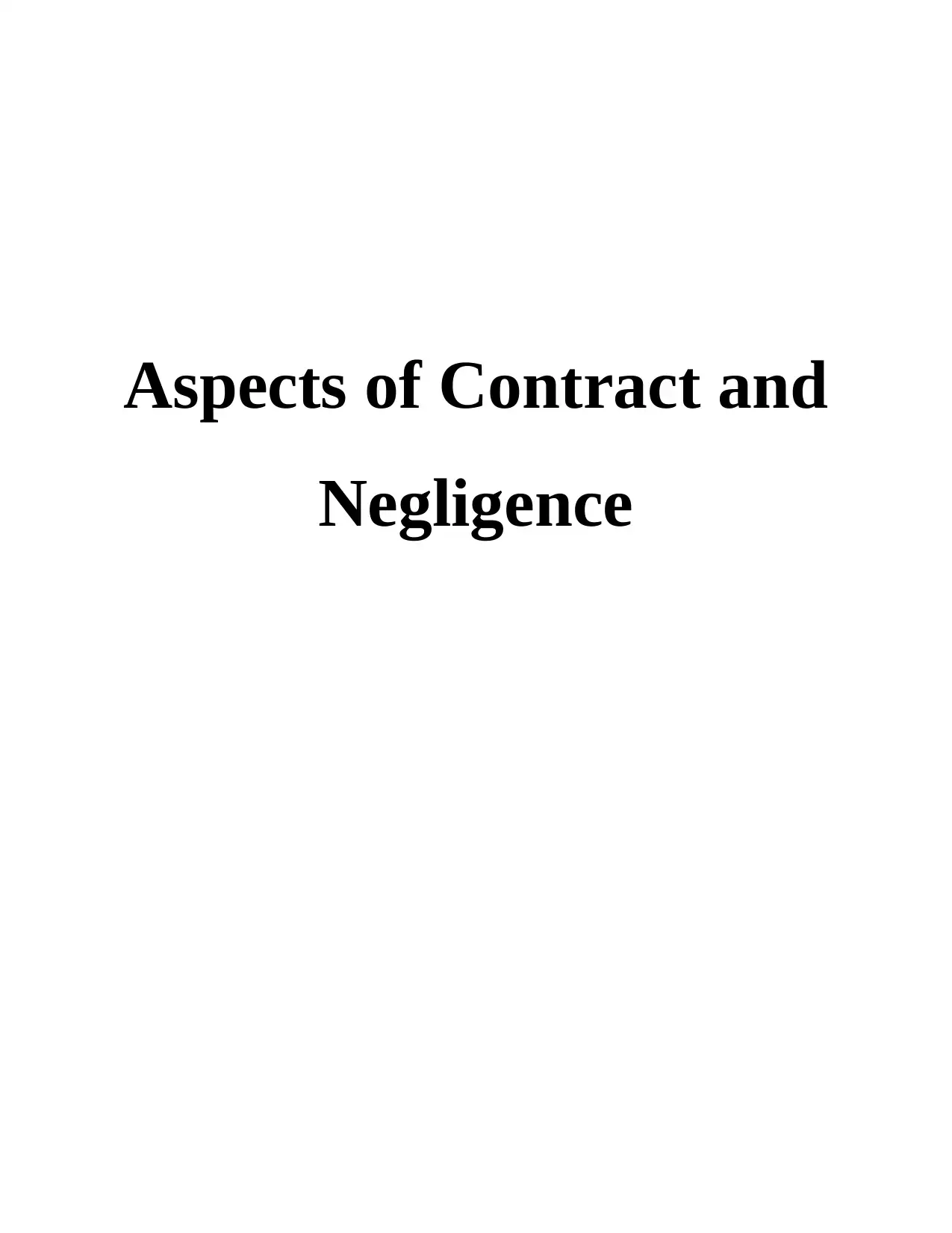
Aspects of Contract and
Negligence
Negligence
Paraphrase This Document
Need a fresh take? Get an instant paraphrase of this document with our AI Paraphraser
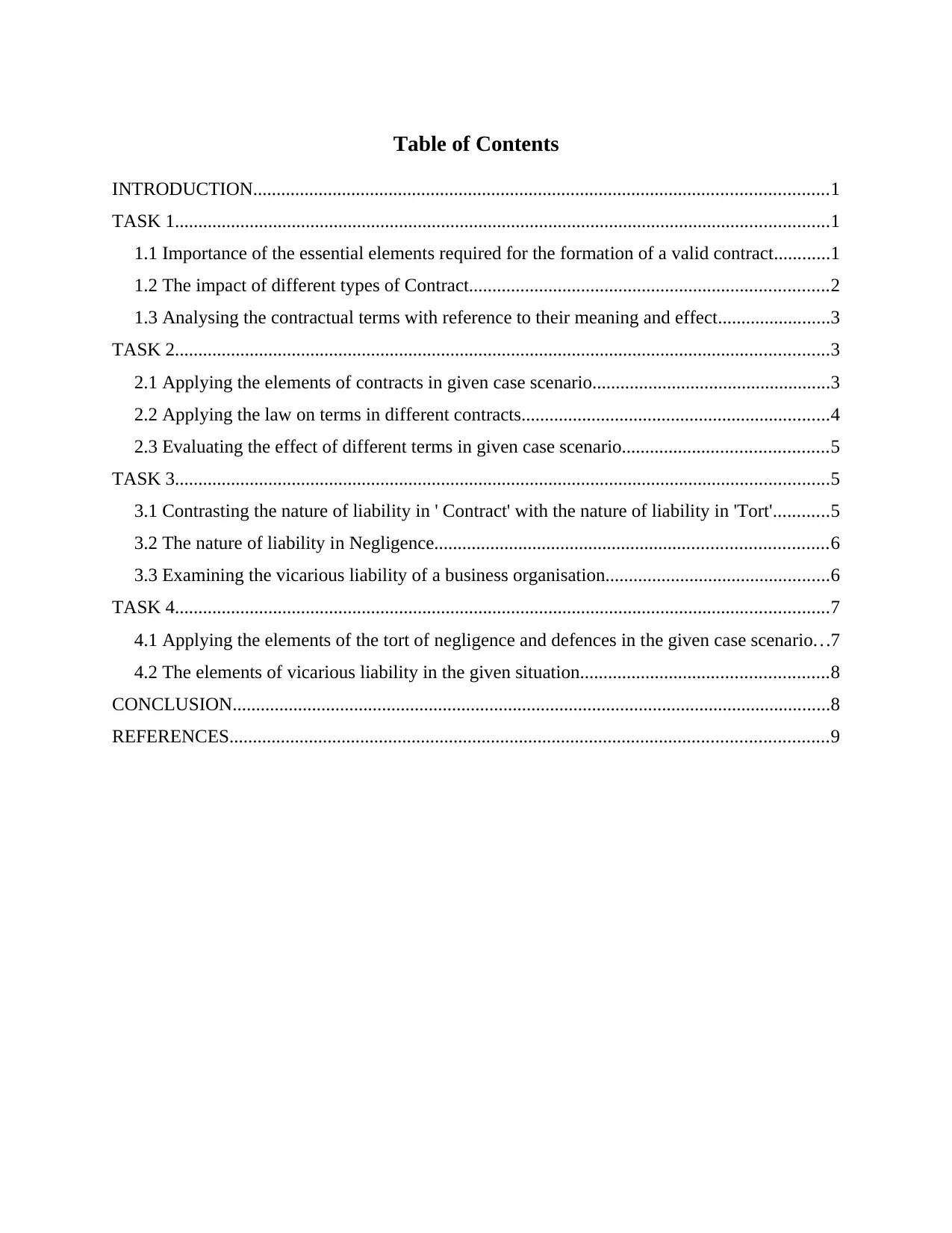
Table of Contents
INTRODUCTION...........................................................................................................................1
TASK 1............................................................................................................................................1
1.1 Importance of the essential elements required for the formation of a valid contract............1
1.2 The impact of different types of Contract.............................................................................2
1.3 Analysing the contractual terms with reference to their meaning and effect........................3
TASK 2............................................................................................................................................3
2.1 Applying the elements of contracts in given case scenario...................................................3
2.2 Applying the law on terms in different contracts..................................................................4
2.3 Evaluating the effect of different terms in given case scenario............................................5
TASK 3............................................................................................................................................5
3.1 Contrasting the nature of liability in ' Contract' with the nature of liability in 'Tort'............5
3.2 The nature of liability in Negligence....................................................................................6
3.3 Examining the vicarious liability of a business organisation................................................6
TASK 4............................................................................................................................................7
4.1 Applying the elements of the tort of negligence and defences in the given case scenario...7
4.2 The elements of vicarious liability in the given situation.....................................................8
CONCLUSION................................................................................................................................8
REFERENCES................................................................................................................................9
INTRODUCTION...........................................................................................................................1
TASK 1............................................................................................................................................1
1.1 Importance of the essential elements required for the formation of a valid contract............1
1.2 The impact of different types of Contract.............................................................................2
1.3 Analysing the contractual terms with reference to their meaning and effect........................3
TASK 2............................................................................................................................................3
2.1 Applying the elements of contracts in given case scenario...................................................3
2.2 Applying the law on terms in different contracts..................................................................4
2.3 Evaluating the effect of different terms in given case scenario............................................5
TASK 3............................................................................................................................................5
3.1 Contrasting the nature of liability in ' Contract' with the nature of liability in 'Tort'............5
3.2 The nature of liability in Negligence....................................................................................6
3.3 Examining the vicarious liability of a business organisation................................................6
TASK 4............................................................................................................................................7
4.1 Applying the elements of the tort of negligence and defences in the given case scenario...7
4.2 The elements of vicarious liability in the given situation.....................................................8
CONCLUSION................................................................................................................................8
REFERENCES................................................................................................................................9
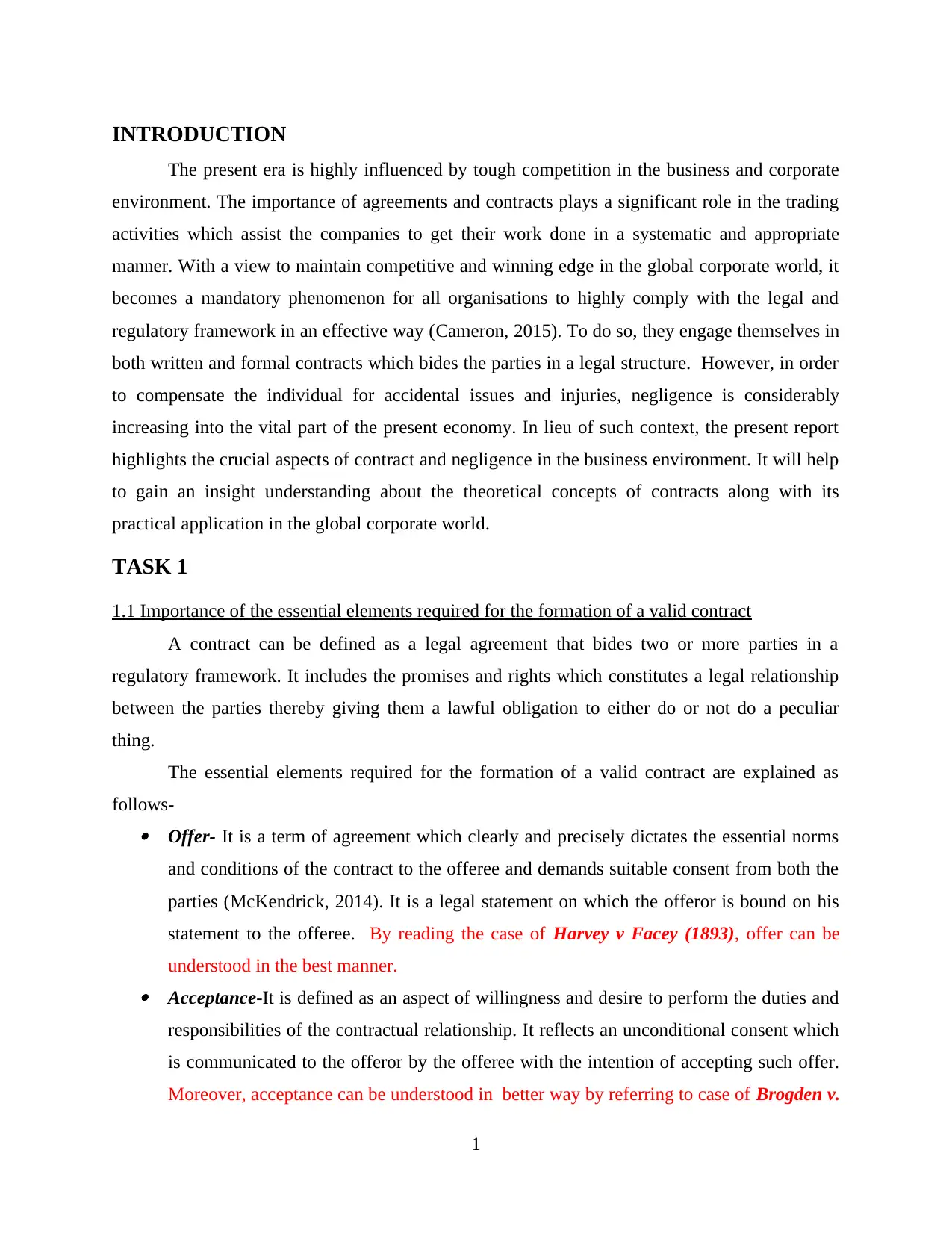
INTRODUCTION
The present era is highly influenced by tough competition in the business and corporate
environment. The importance of agreements and contracts plays a significant role in the trading
activities which assist the companies to get their work done in a systematic and appropriate
manner. With a view to maintain competitive and winning edge in the global corporate world, it
becomes a mandatory phenomenon for all organisations to highly comply with the legal and
regulatory framework in an effective way (Cameron, 2015). To do so, they engage themselves in
both written and formal contracts which bides the parties in a legal structure. However, in order
to compensate the individual for accidental issues and injuries, negligence is considerably
increasing into the vital part of the present economy. In lieu of such context, the present report
highlights the crucial aspects of contract and negligence in the business environment. It will help
to gain an insight understanding about the theoretical concepts of contracts along with its
practical application in the global corporate world.
TASK 1
1.1 Importance of the essential elements required for the formation of a valid contract
A contract can be defined as a legal agreement that bides two or more parties in a
regulatory framework. It includes the promises and rights which constitutes a legal relationship
between the parties thereby giving them a lawful obligation to either do or not do a peculiar
thing.
The essential elements required for the formation of a valid contract are explained as
follows- Offer- It is a term of agreement which clearly and precisely dictates the essential norms
and conditions of the contract to the offeree and demands suitable consent from both the
parties (McKendrick, 2014). It is a legal statement on which the offeror is bound on his
statement to the offeree. By reading the case of Harvey v Facey (1893), offer can be
understood in the best manner. Acceptance-It is defined as an aspect of willingness and desire to perform the duties and
responsibilities of the contractual relationship. It reflects an unconditional consent which
is communicated to the offeror by the offeree with the intention of accepting such offer.
Moreover, acceptance can be understood in better way by referring to case of Brogden v.
1
The present era is highly influenced by tough competition in the business and corporate
environment. The importance of agreements and contracts plays a significant role in the trading
activities which assist the companies to get their work done in a systematic and appropriate
manner. With a view to maintain competitive and winning edge in the global corporate world, it
becomes a mandatory phenomenon for all organisations to highly comply with the legal and
regulatory framework in an effective way (Cameron, 2015). To do so, they engage themselves in
both written and formal contracts which bides the parties in a legal structure. However, in order
to compensate the individual for accidental issues and injuries, negligence is considerably
increasing into the vital part of the present economy. In lieu of such context, the present report
highlights the crucial aspects of contract and negligence in the business environment. It will help
to gain an insight understanding about the theoretical concepts of contracts along with its
practical application in the global corporate world.
TASK 1
1.1 Importance of the essential elements required for the formation of a valid contract
A contract can be defined as a legal agreement that bides two or more parties in a
regulatory framework. It includes the promises and rights which constitutes a legal relationship
between the parties thereby giving them a lawful obligation to either do or not do a peculiar
thing.
The essential elements required for the formation of a valid contract are explained as
follows- Offer- It is a term of agreement which clearly and precisely dictates the essential norms
and conditions of the contract to the offeree and demands suitable consent from both the
parties (McKendrick, 2014). It is a legal statement on which the offeror is bound on his
statement to the offeree. By reading the case of Harvey v Facey (1893), offer can be
understood in the best manner. Acceptance-It is defined as an aspect of willingness and desire to perform the duties and
responsibilities of the contractual relationship. It reflects an unconditional consent which
is communicated to the offeror by the offeree with the intention of accepting such offer.
Moreover, acceptance can be understood in better way by referring to case of Brogden v.
1
⊘ This is a preview!⊘
Do you want full access?
Subscribe today to unlock all pages.

Trusted by 1+ million students worldwide
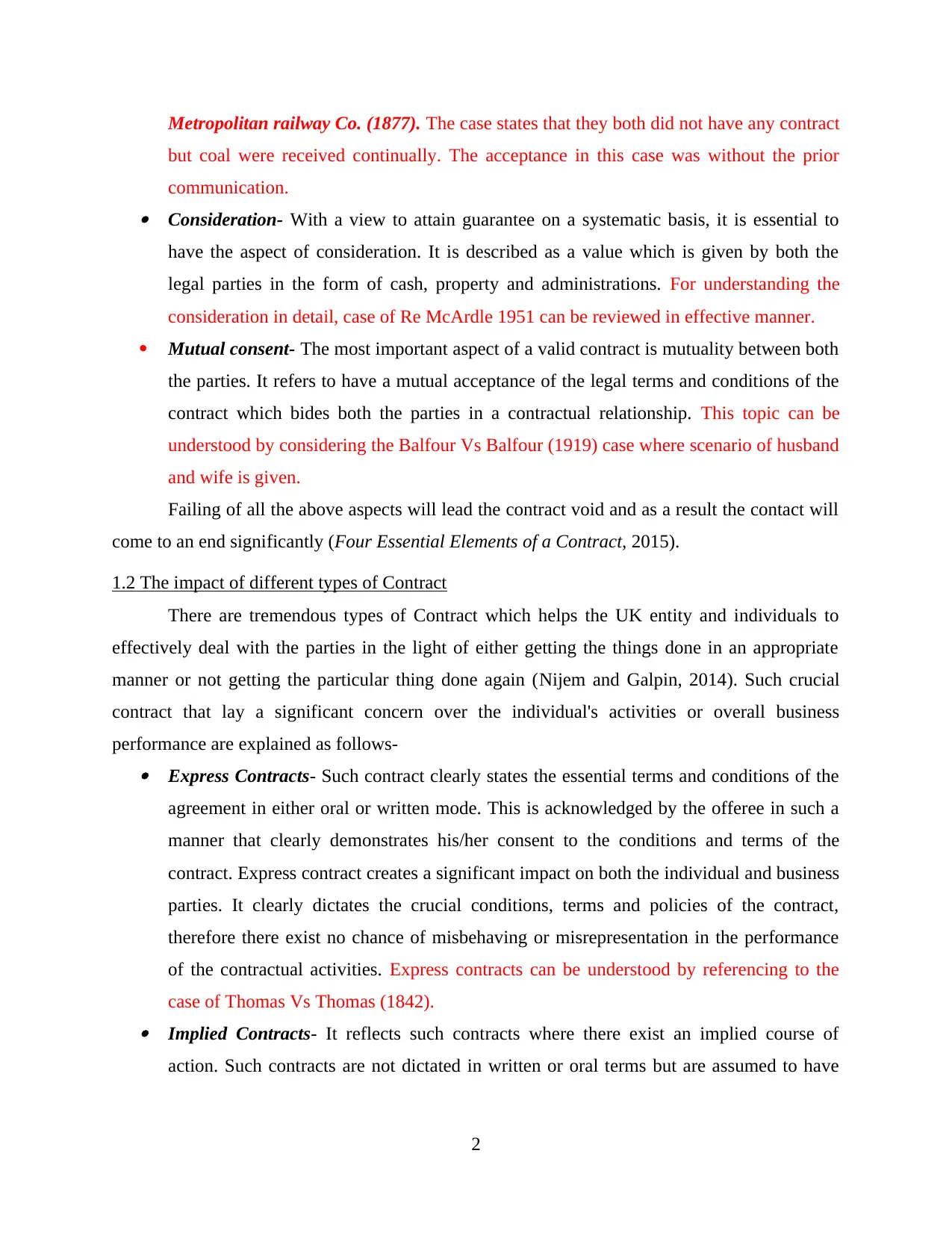
Metropolitan railway Co. (1877). The case states that they both did not have any contract
but coal were received continually. The acceptance in this case was without the prior
communication. Consideration- With a view to attain guarantee on a systematic basis, it is essential to
have the aspect of consideration. It is described as a value which is given by both the
legal parties in the form of cash, property and administrations. For understanding the
consideration in detail, case of Re McArdle 1951 can be reviewed in effective manner.
Mutual consent- The most important aspect of a valid contract is mutuality between both
the parties. It refers to have a mutual acceptance of the legal terms and conditions of the
contract which bides both the parties in a contractual relationship. This topic can be
understood by considering the Balfour Vs Balfour (1919) case where scenario of husband
and wife is given.
Failing of all the above aspects will lead the contract void and as a result the contact will
come to an end significantly (Four Essential Elements of a Contract, 2015).
1.2 The impact of different types of Contract
There are tremendous types of Contract which helps the UK entity and individuals to
effectively deal with the parties in the light of either getting the things done in an appropriate
manner or not getting the particular thing done again (Nijem and Galpin, 2014). Such crucial
contract that lay a significant concern over the individual's activities or overall business
performance are explained as follows- Express Contracts- Such contract clearly states the essential terms and conditions of the
agreement in either oral or written mode. This is acknowledged by the offeree in such a
manner that clearly demonstrates his/her consent to the conditions and terms of the
contract. Express contract creates a significant impact on both the individual and business
parties. It clearly dictates the crucial conditions, terms and policies of the contract,
therefore there exist no chance of misbehaving or misrepresentation in the performance
of the contractual activities. Express contracts can be understood by referencing to the
case of Thomas Vs Thomas (1842). Implied Contracts- It reflects such contracts where there exist an implied course of
action. Such contracts are not dictated in written or oral terms but are assumed to have
2
but coal were received continually. The acceptance in this case was without the prior
communication. Consideration- With a view to attain guarantee on a systematic basis, it is essential to
have the aspect of consideration. It is described as a value which is given by both the
legal parties in the form of cash, property and administrations. For understanding the
consideration in detail, case of Re McArdle 1951 can be reviewed in effective manner.
Mutual consent- The most important aspect of a valid contract is mutuality between both
the parties. It refers to have a mutual acceptance of the legal terms and conditions of the
contract which bides both the parties in a contractual relationship. This topic can be
understood by considering the Balfour Vs Balfour (1919) case where scenario of husband
and wife is given.
Failing of all the above aspects will lead the contract void and as a result the contact will
come to an end significantly (Four Essential Elements of a Contract, 2015).
1.2 The impact of different types of Contract
There are tremendous types of Contract which helps the UK entity and individuals to
effectively deal with the parties in the light of either getting the things done in an appropriate
manner or not getting the particular thing done again (Nijem and Galpin, 2014). Such crucial
contract that lay a significant concern over the individual's activities or overall business
performance are explained as follows- Express Contracts- Such contract clearly states the essential terms and conditions of the
agreement in either oral or written mode. This is acknowledged by the offeree in such a
manner that clearly demonstrates his/her consent to the conditions and terms of the
contract. Express contract creates a significant impact on both the individual and business
parties. It clearly dictates the crucial conditions, terms and policies of the contract,
therefore there exist no chance of misbehaving or misrepresentation in the performance
of the contractual activities. Express contracts can be understood by referencing to the
case of Thomas Vs Thomas (1842). Implied Contracts- It reflects such contracts where there exist an implied course of
action. Such contracts are not dictated in written or oral terms but are assumed to have
2
Paraphrase This Document
Need a fresh take? Get an instant paraphrase of this document with our AI Paraphraser
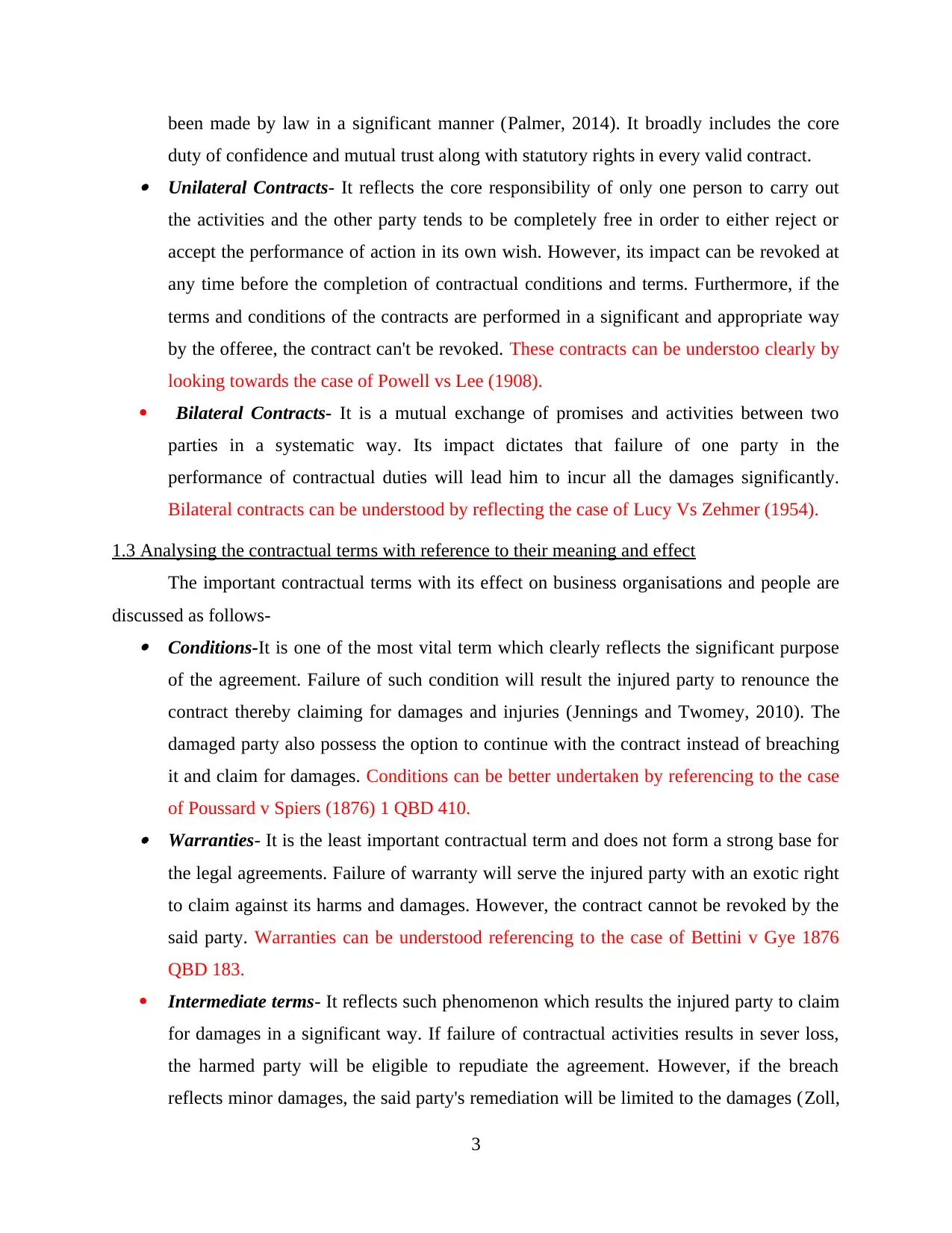
been made by law in a significant manner (Palmer, 2014). It broadly includes the core
duty of confidence and mutual trust along with statutory rights in every valid contract. Unilateral Contracts- It reflects the core responsibility of only one person to carry out
the activities and the other party tends to be completely free in order to either reject or
accept the performance of action in its own wish. However, its impact can be revoked at
any time before the completion of contractual conditions and terms. Furthermore, if the
terms and conditions of the contracts are performed in a significant and appropriate way
by the offeree, the contract can't be revoked. These contracts can be understoo clearly by
looking towards the case of Powell vs Lee (1908).
Bilateral Contracts- It is a mutual exchange of promises and activities between two
parties in a systematic way. Its impact dictates that failure of one party in the
performance of contractual duties will lead him to incur all the damages significantly.
Bilateral contracts can be understood by reflecting the case of Lucy Vs Zehmer (1954).
1.3 Analysing the contractual terms with reference to their meaning and effect
The important contractual terms with its effect on business organisations and people are
discussed as follows- Conditions-It is one of the most vital term which clearly reflects the significant purpose
of the agreement. Failure of such condition will result the injured party to renounce the
contract thereby claiming for damages and injuries (Jennings and Twomey, 2010). The
damaged party also possess the option to continue with the contract instead of breaching
it and claim for damages. Conditions can be better undertaken by referencing to the case
of Poussard v Spiers (1876) 1 QBD 410. Warranties- It is the least important contractual term and does not form a strong base for
the legal agreements. Failure of warranty will serve the injured party with an exotic right
to claim against its harms and damages. However, the contract cannot be revoked by the
said party. Warranties can be understood referencing to the case of Bettini v Gye 1876
QBD 183.
Intermediate terms- It reflects such phenomenon which results the injured party to claim
for damages in a significant way. If failure of contractual activities results in sever loss,
the harmed party will be eligible to repudiate the agreement. However, if the breach
reflects minor damages, the said party's remediation will be limited to the damages (Zoll,
3
duty of confidence and mutual trust along with statutory rights in every valid contract. Unilateral Contracts- It reflects the core responsibility of only one person to carry out
the activities and the other party tends to be completely free in order to either reject or
accept the performance of action in its own wish. However, its impact can be revoked at
any time before the completion of contractual conditions and terms. Furthermore, if the
terms and conditions of the contracts are performed in a significant and appropriate way
by the offeree, the contract can't be revoked. These contracts can be understoo clearly by
looking towards the case of Powell vs Lee (1908).
Bilateral Contracts- It is a mutual exchange of promises and activities between two
parties in a systematic way. Its impact dictates that failure of one party in the
performance of contractual duties will lead him to incur all the damages significantly.
Bilateral contracts can be understood by reflecting the case of Lucy Vs Zehmer (1954).
1.3 Analysing the contractual terms with reference to their meaning and effect
The important contractual terms with its effect on business organisations and people are
discussed as follows- Conditions-It is one of the most vital term which clearly reflects the significant purpose
of the agreement. Failure of such condition will result the injured party to renounce the
contract thereby claiming for damages and injuries (Jennings and Twomey, 2010). The
damaged party also possess the option to continue with the contract instead of breaching
it and claim for damages. Conditions can be better undertaken by referencing to the case
of Poussard v Spiers (1876) 1 QBD 410. Warranties- It is the least important contractual term and does not form a strong base for
the legal agreements. Failure of warranty will serve the injured party with an exotic right
to claim against its harms and damages. However, the contract cannot be revoked by the
said party. Warranties can be understood referencing to the case of Bettini v Gye 1876
QBD 183.
Intermediate terms- It reflects such phenomenon which results the injured party to claim
for damages in a significant way. If failure of contractual activities results in sever loss,
the harmed party will be eligible to repudiate the agreement. However, if the breach
reflects minor damages, the said party's remediation will be limited to the damages (Zoll,
3
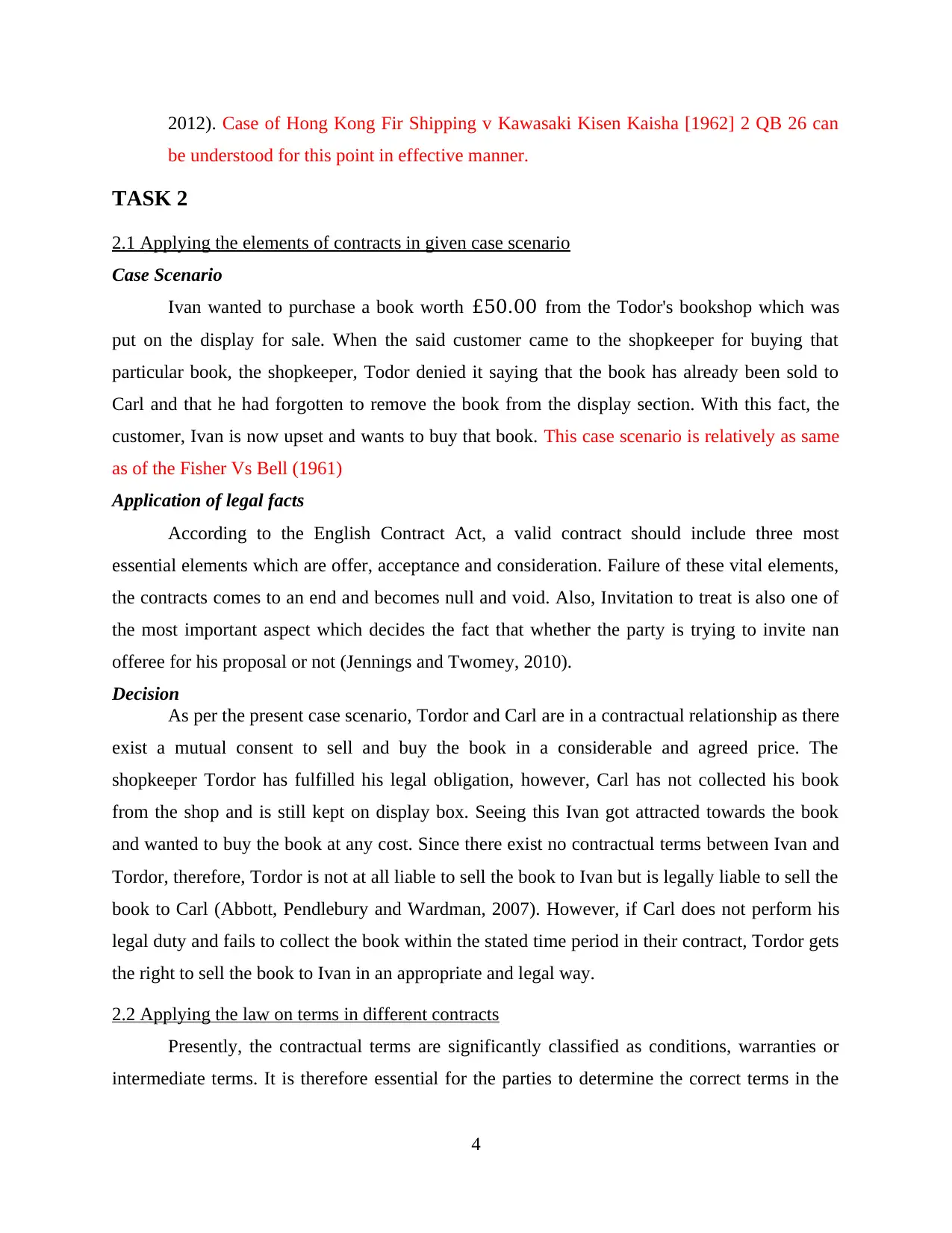
2012). Case of Hong Kong Fir Shipping v Kawasaki Kisen Kaisha [1962] 2 QB 26 can
be understood for this point in effective manner.
TASK 2
2.1 Applying the elements of contracts in given case scenario
Case Scenario
Ivan wanted to purchase a book worth £50.00 from the Todor's bookshop which was
put on the display for sale. When the said customer came to the shopkeeper for buying that
particular book, the shopkeeper, Todor denied it saying that the book has already been sold to
Carl and that he had forgotten to remove the book from the display section. With this fact, the
customer, Ivan is now upset and wants to buy that book. This case scenario is relatively as same
as of the Fisher Vs Bell (1961)
Application of legal facts
According to the English Contract Act, a valid contract should include three most
essential elements which are offer, acceptance and consideration. Failure of these vital elements,
the contracts comes to an end and becomes null and void. Also, Invitation to treat is also one of
the most important aspect which decides the fact that whether the party is trying to invite nan
offeree for his proposal or not (Jennings and Twomey, 2010).
Decision
As per the present case scenario, Tordor and Carl are in a contractual relationship as there
exist a mutual consent to sell and buy the book in a considerable and agreed price. The
shopkeeper Tordor has fulfilled his legal obligation, however, Carl has not collected his book
from the shop and is still kept on display box. Seeing this Ivan got attracted towards the book
and wanted to buy the book at any cost. Since there exist no contractual terms between Ivan and
Tordor, therefore, Tordor is not at all liable to sell the book to Ivan but is legally liable to sell the
book to Carl (Abbott, Pendlebury and Wardman, 2007). However, if Carl does not perform his
legal duty and fails to collect the book within the stated time period in their contract, Tordor gets
the right to sell the book to Ivan in an appropriate and legal way.
2.2 Applying the law on terms in different contracts
Presently, the contractual terms are significantly classified as conditions, warranties or
intermediate terms. It is therefore essential for the parties to determine the correct terms in the
4
be understood for this point in effective manner.
TASK 2
2.1 Applying the elements of contracts in given case scenario
Case Scenario
Ivan wanted to purchase a book worth £50.00 from the Todor's bookshop which was
put on the display for sale. When the said customer came to the shopkeeper for buying that
particular book, the shopkeeper, Todor denied it saying that the book has already been sold to
Carl and that he had forgotten to remove the book from the display section. With this fact, the
customer, Ivan is now upset and wants to buy that book. This case scenario is relatively as same
as of the Fisher Vs Bell (1961)
Application of legal facts
According to the English Contract Act, a valid contract should include three most
essential elements which are offer, acceptance and consideration. Failure of these vital elements,
the contracts comes to an end and becomes null and void. Also, Invitation to treat is also one of
the most important aspect which decides the fact that whether the party is trying to invite nan
offeree for his proposal or not (Jennings and Twomey, 2010).
Decision
As per the present case scenario, Tordor and Carl are in a contractual relationship as there
exist a mutual consent to sell and buy the book in a considerable and agreed price. The
shopkeeper Tordor has fulfilled his legal obligation, however, Carl has not collected his book
from the shop and is still kept on display box. Seeing this Ivan got attracted towards the book
and wanted to buy the book at any cost. Since there exist no contractual terms between Ivan and
Tordor, therefore, Tordor is not at all liable to sell the book to Ivan but is legally liable to sell the
book to Carl (Abbott, Pendlebury and Wardman, 2007). However, if Carl does not perform his
legal duty and fails to collect the book within the stated time period in their contract, Tordor gets
the right to sell the book to Ivan in an appropriate and legal way.
2.2 Applying the law on terms in different contracts
Presently, the contractual terms are significantly classified as conditions, warranties or
intermediate terms. It is therefore essential for the parties to determine the correct terms in the
4
⊘ This is a preview!⊘
Do you want full access?
Subscribe today to unlock all pages.

Trusted by 1+ million students worldwide
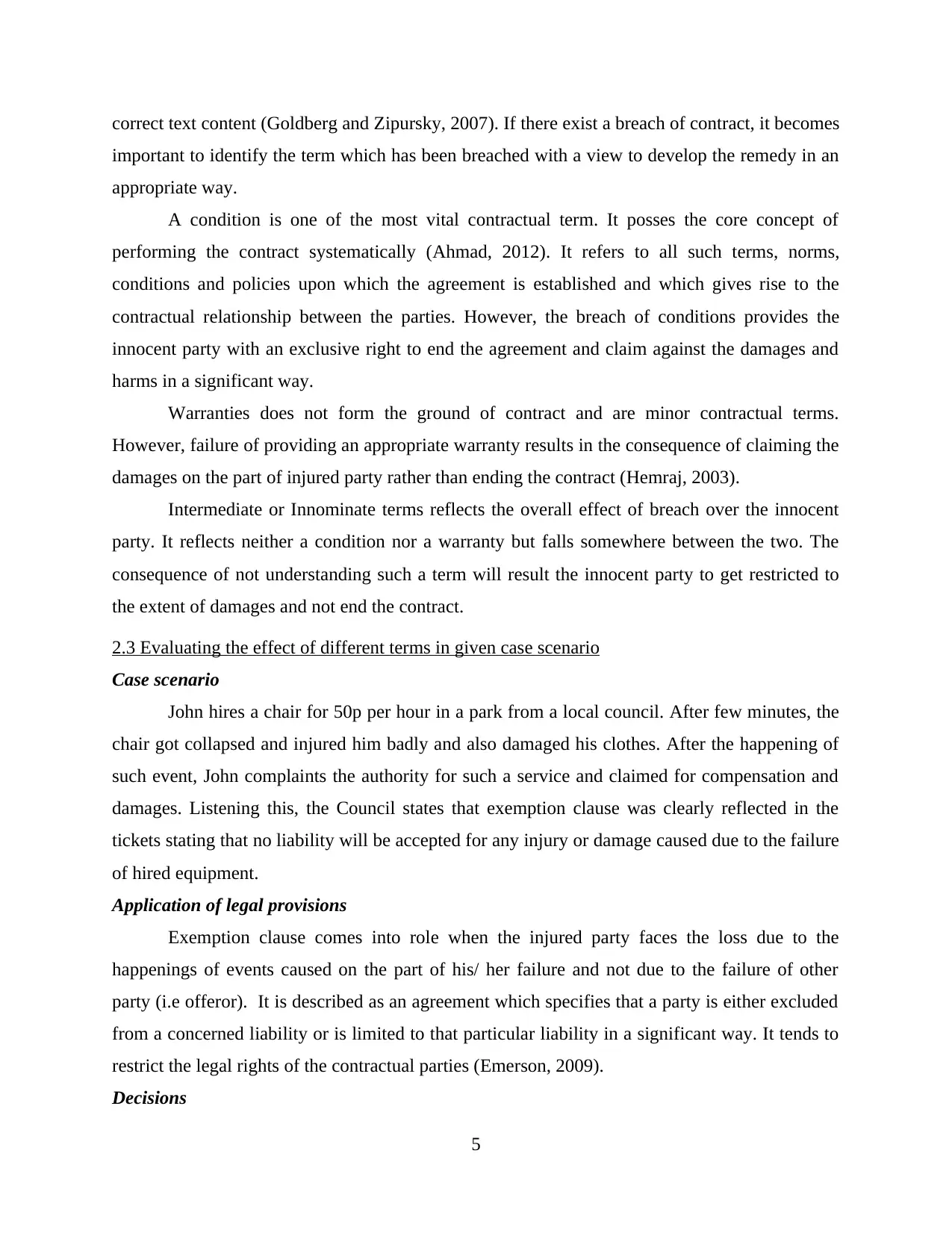
correct text content (Goldberg and Zipursky, 2007). If there exist a breach of contract, it becomes
important to identify the term which has been breached with a view to develop the remedy in an
appropriate way.
A condition is one of the most vital contractual term. It posses the core concept of
performing the contract systematically (Ahmad, 2012). It refers to all such terms, norms,
conditions and policies upon which the agreement is established and which gives rise to the
contractual relationship between the parties. However, the breach of conditions provides the
innocent party with an exclusive right to end the agreement and claim against the damages and
harms in a significant way.
Warranties does not form the ground of contract and are minor contractual terms.
However, failure of providing an appropriate warranty results in the consequence of claiming the
damages on the part of injured party rather than ending the contract (Hemraj, 2003).
Intermediate or Innominate terms reflects the overall effect of breach over the innocent
party. It reflects neither a condition nor a warranty but falls somewhere between the two. The
consequence of not understanding such a term will result the innocent party to get restricted to
the extent of damages and not end the contract.
2.3 Evaluating the effect of different terms in given case scenario
Case scenario
John hires a chair for 50p per hour in a park from a local council. After few minutes, the
chair got collapsed and injured him badly and also damaged his clothes. After the happening of
such event, John complaints the authority for such a service and claimed for compensation and
damages. Listening this, the Council states that exemption clause was clearly reflected in the
tickets stating that no liability will be accepted for any injury or damage caused due to the failure
of hired equipment.
Application of legal provisions
Exemption clause comes into role when the injured party faces the loss due to the
happenings of events caused on the part of his/ her failure and not due to the failure of other
party (i.e offeror). It is described as an agreement which specifies that a party is either excluded
from a concerned liability or is limited to that particular liability in a significant way. It tends to
restrict the legal rights of the contractual parties (Emerson, 2009).
Decisions
5
important to identify the term which has been breached with a view to develop the remedy in an
appropriate way.
A condition is one of the most vital contractual term. It posses the core concept of
performing the contract systematically (Ahmad, 2012). It refers to all such terms, norms,
conditions and policies upon which the agreement is established and which gives rise to the
contractual relationship between the parties. However, the breach of conditions provides the
innocent party with an exclusive right to end the agreement and claim against the damages and
harms in a significant way.
Warranties does not form the ground of contract and are minor contractual terms.
However, failure of providing an appropriate warranty results in the consequence of claiming the
damages on the part of injured party rather than ending the contract (Hemraj, 2003).
Intermediate or Innominate terms reflects the overall effect of breach over the innocent
party. It reflects neither a condition nor a warranty but falls somewhere between the two. The
consequence of not understanding such a term will result the innocent party to get restricted to
the extent of damages and not end the contract.
2.3 Evaluating the effect of different terms in given case scenario
Case scenario
John hires a chair for 50p per hour in a park from a local council. After few minutes, the
chair got collapsed and injured him badly and also damaged his clothes. After the happening of
such event, John complaints the authority for such a service and claimed for compensation and
damages. Listening this, the Council states that exemption clause was clearly reflected in the
tickets stating that no liability will be accepted for any injury or damage caused due to the failure
of hired equipment.
Application of legal provisions
Exemption clause comes into role when the injured party faces the loss due to the
happenings of events caused on the part of his/ her failure and not due to the failure of other
party (i.e offeror). It is described as an agreement which specifies that a party is either excluded
from a concerned liability or is limited to that particular liability in a significant way. It tends to
restrict the legal rights of the contractual parties (Emerson, 2009).
Decisions
5
Paraphrase This Document
Need a fresh take? Get an instant paraphrase of this document with our AI Paraphraser
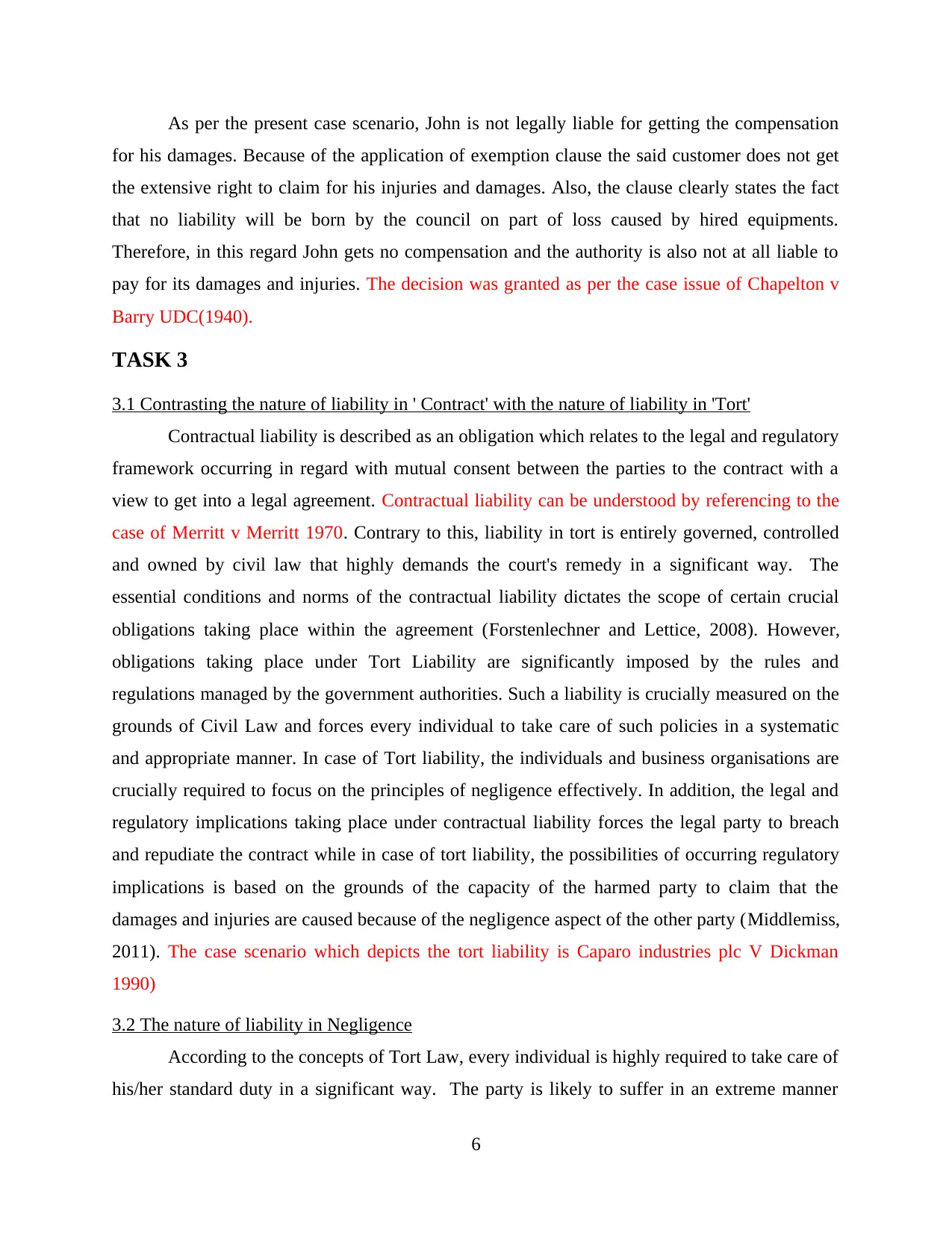
As per the present case scenario, John is not legally liable for getting the compensation
for his damages. Because of the application of exemption clause the said customer does not get
the extensive right to claim for his injuries and damages. Also, the clause clearly states the fact
that no liability will be born by the council on part of loss caused by hired equipments.
Therefore, in this regard John gets no compensation and the authority is also not at all liable to
pay for its damages and injuries. The decision was granted as per the case issue of Chapelton v
Barry UDC(1940).
TASK 3
3.1 Contrasting the nature of liability in ' Contract' with the nature of liability in 'Tort'
Contractual liability is described as an obligation which relates to the legal and regulatory
framework occurring in regard with mutual consent between the parties to the contract with a
view to get into a legal agreement. Contractual liability can be understood by referencing to the
case of Merritt v Merritt 1970. Contrary to this, liability in tort is entirely governed, controlled
and owned by civil law that highly demands the court's remedy in a significant way. The
essential conditions and norms of the contractual liability dictates the scope of certain crucial
obligations taking place within the agreement (Forstenlechner and Lettice, 2008). However,
obligations taking place under Tort Liability are significantly imposed by the rules and
regulations managed by the government authorities. Such a liability is crucially measured on the
grounds of Civil Law and forces every individual to take care of such policies in a systematic
and appropriate manner. In case of Tort liability, the individuals and business organisations are
crucially required to focus on the principles of negligence effectively. In addition, the legal and
regulatory implications taking place under contractual liability forces the legal party to breach
and repudiate the contract while in case of tort liability, the possibilities of occurring regulatory
implications is based on the grounds of the capacity of the harmed party to claim that the
damages and injuries are caused because of the negligence aspect of the other party (Middlemiss,
2011). The case scenario which depicts the tort liability is Caparo industries plc V Dickman
1990)
3.2 The nature of liability in Negligence
According to the concepts of Tort Law, every individual is highly required to take care of
his/her standard duty in a significant way. The party is likely to suffer in an extreme manner
6
for his damages. Because of the application of exemption clause the said customer does not get
the extensive right to claim for his injuries and damages. Also, the clause clearly states the fact
that no liability will be born by the council on part of loss caused by hired equipments.
Therefore, in this regard John gets no compensation and the authority is also not at all liable to
pay for its damages and injuries. The decision was granted as per the case issue of Chapelton v
Barry UDC(1940).
TASK 3
3.1 Contrasting the nature of liability in ' Contract' with the nature of liability in 'Tort'
Contractual liability is described as an obligation which relates to the legal and regulatory
framework occurring in regard with mutual consent between the parties to the contract with a
view to get into a legal agreement. Contractual liability can be understood by referencing to the
case of Merritt v Merritt 1970. Contrary to this, liability in tort is entirely governed, controlled
and owned by civil law that highly demands the court's remedy in a significant way. The
essential conditions and norms of the contractual liability dictates the scope of certain crucial
obligations taking place within the agreement (Forstenlechner and Lettice, 2008). However,
obligations taking place under Tort Liability are significantly imposed by the rules and
regulations managed by the government authorities. Such a liability is crucially measured on the
grounds of Civil Law and forces every individual to take care of such policies in a systematic
and appropriate manner. In case of Tort liability, the individuals and business organisations are
crucially required to focus on the principles of negligence effectively. In addition, the legal and
regulatory implications taking place under contractual liability forces the legal party to breach
and repudiate the contract while in case of tort liability, the possibilities of occurring regulatory
implications is based on the grounds of the capacity of the harmed party to claim that the
damages and injuries are caused because of the negligence aspect of the other party (Middlemiss,
2011). The case scenario which depicts the tort liability is Caparo industries plc V Dickman
1990)
3.2 The nature of liability in Negligence
According to the concepts of Tort Law, every individual is highly required to take care of
his/her standard duty in a significant way. The party is likely to suffer in an extreme manner
6
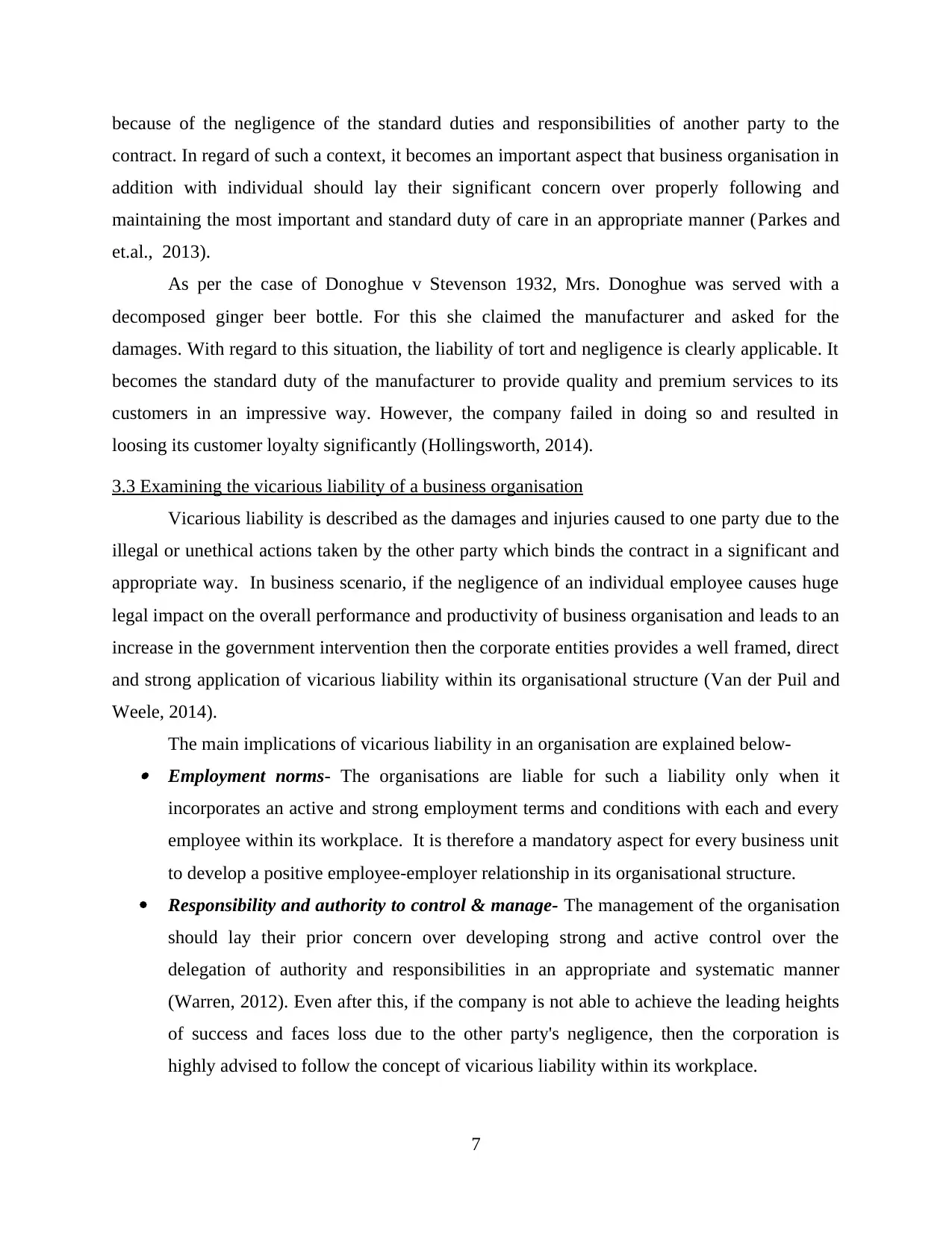
because of the negligence of the standard duties and responsibilities of another party to the
contract. In regard of such a context, it becomes an important aspect that business organisation in
addition with individual should lay their significant concern over properly following and
maintaining the most important and standard duty of care in an appropriate manner (Parkes and
et.al., 2013).
As per the case of Donoghue v Stevenson 1932, Mrs. Donoghue was served with a
decomposed ginger beer bottle. For this she claimed the manufacturer and asked for the
damages. With regard to this situation, the liability of tort and negligence is clearly applicable. It
becomes the standard duty of the manufacturer to provide quality and premium services to its
customers in an impressive way. However, the company failed in doing so and resulted in
loosing its customer loyalty significantly (Hollingsworth, 2014).
3.3 Examining the vicarious liability of a business organisation
Vicarious liability is described as the damages and injuries caused to one party due to the
illegal or unethical actions taken by the other party which binds the contract in a significant and
appropriate way. In business scenario, if the negligence of an individual employee causes huge
legal impact on the overall performance and productivity of business organisation and leads to an
increase in the government intervention then the corporate entities provides a well framed, direct
and strong application of vicarious liability within its organisational structure (Van der Puil and
Weele, 2014).
The main implications of vicarious liability in an organisation are explained below- Employment norms- The organisations are liable for such a liability only when it
incorporates an active and strong employment terms and conditions with each and every
employee within its workplace. It is therefore a mandatory aspect for every business unit
to develop a positive employee-employer relationship in its organisational structure.
Responsibility and authority to control & manage- The management of the organisation
should lay their prior concern over developing strong and active control over the
delegation of authority and responsibilities in an appropriate and systematic manner
(Warren, 2012). Even after this, if the company is not able to achieve the leading heights
of success and faces loss due to the other party's negligence, then the corporation is
highly advised to follow the concept of vicarious liability within its workplace.
7
contract. In regard of such a context, it becomes an important aspect that business organisation in
addition with individual should lay their significant concern over properly following and
maintaining the most important and standard duty of care in an appropriate manner (Parkes and
et.al., 2013).
As per the case of Donoghue v Stevenson 1932, Mrs. Donoghue was served with a
decomposed ginger beer bottle. For this she claimed the manufacturer and asked for the
damages. With regard to this situation, the liability of tort and negligence is clearly applicable. It
becomes the standard duty of the manufacturer to provide quality and premium services to its
customers in an impressive way. However, the company failed in doing so and resulted in
loosing its customer loyalty significantly (Hollingsworth, 2014).
3.3 Examining the vicarious liability of a business organisation
Vicarious liability is described as the damages and injuries caused to one party due to the
illegal or unethical actions taken by the other party which binds the contract in a significant and
appropriate way. In business scenario, if the negligence of an individual employee causes huge
legal impact on the overall performance and productivity of business organisation and leads to an
increase in the government intervention then the corporate entities provides a well framed, direct
and strong application of vicarious liability within its organisational structure (Van der Puil and
Weele, 2014).
The main implications of vicarious liability in an organisation are explained below- Employment norms- The organisations are liable for such a liability only when it
incorporates an active and strong employment terms and conditions with each and every
employee within its workplace. It is therefore a mandatory aspect for every business unit
to develop a positive employee-employer relationship in its organisational structure.
Responsibility and authority to control & manage- The management of the organisation
should lay their prior concern over developing strong and active control over the
delegation of authority and responsibilities in an appropriate and systematic manner
(Warren, 2012). Even after this, if the company is not able to achieve the leading heights
of success and faces loss due to the other party's negligence, then the corporation is
highly advised to follow the concept of vicarious liability within its workplace.
7
⊘ This is a preview!⊘
Do you want full access?
Subscribe today to unlock all pages.

Trusted by 1+ million students worldwide
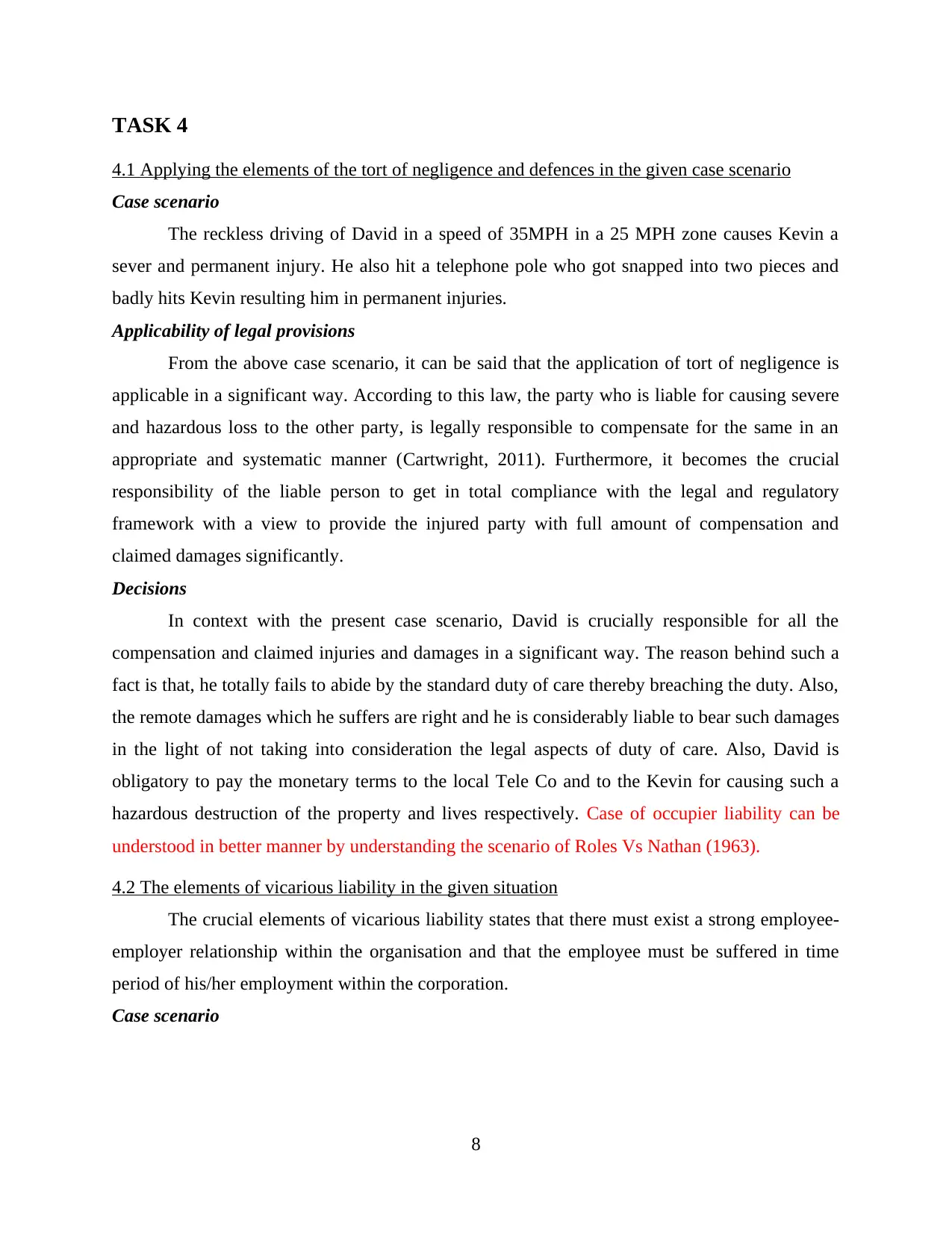
TASK 4
4.1 Applying the elements of the tort of negligence and defences in the given case scenario
Case scenario
The reckless driving of David in a speed of 35MPH in a 25 MPH zone causes Kevin a
sever and permanent injury. He also hit a telephone pole who got snapped into two pieces and
badly hits Kevin resulting him in permanent injuries.
Applicability of legal provisions
From the above case scenario, it can be said that the application of tort of negligence is
applicable in a significant way. According to this law, the party who is liable for causing severe
and hazardous loss to the other party, is legally responsible to compensate for the same in an
appropriate and systematic manner (Cartwright, 2011). Furthermore, it becomes the crucial
responsibility of the liable person to get in total compliance with the legal and regulatory
framework with a view to provide the injured party with full amount of compensation and
claimed damages significantly.
Decisions
In context with the present case scenario, David is crucially responsible for all the
compensation and claimed injuries and damages in a significant way. The reason behind such a
fact is that, he totally fails to abide by the standard duty of care thereby breaching the duty. Also,
the remote damages which he suffers are right and he is considerably liable to bear such damages
in the light of not taking into consideration the legal aspects of duty of care. Also, David is
obligatory to pay the monetary terms to the local Tele Co and to the Kevin for causing such a
hazardous destruction of the property and lives respectively. Case of occupier liability can be
understood in better manner by understanding the scenario of Roles Vs Nathan (1963).
4.2 The elements of vicarious liability in the given situation
The crucial elements of vicarious liability states that there must exist a strong employee-
employer relationship within the organisation and that the employee must be suffered in time
period of his/her employment within the corporation.
Case scenario
8
4.1 Applying the elements of the tort of negligence and defences in the given case scenario
Case scenario
The reckless driving of David in a speed of 35MPH in a 25 MPH zone causes Kevin a
sever and permanent injury. He also hit a telephone pole who got snapped into two pieces and
badly hits Kevin resulting him in permanent injuries.
Applicability of legal provisions
From the above case scenario, it can be said that the application of tort of negligence is
applicable in a significant way. According to this law, the party who is liable for causing severe
and hazardous loss to the other party, is legally responsible to compensate for the same in an
appropriate and systematic manner (Cartwright, 2011). Furthermore, it becomes the crucial
responsibility of the liable person to get in total compliance with the legal and regulatory
framework with a view to provide the injured party with full amount of compensation and
claimed damages significantly.
Decisions
In context with the present case scenario, David is crucially responsible for all the
compensation and claimed injuries and damages in a significant way. The reason behind such a
fact is that, he totally fails to abide by the standard duty of care thereby breaching the duty. Also,
the remote damages which he suffers are right and he is considerably liable to bear such damages
in the light of not taking into consideration the legal aspects of duty of care. Also, David is
obligatory to pay the monetary terms to the local Tele Co and to the Kevin for causing such a
hazardous destruction of the property and lives respectively. Case of occupier liability can be
understood in better manner by understanding the scenario of Roles Vs Nathan (1963).
4.2 The elements of vicarious liability in the given situation
The crucial elements of vicarious liability states that there must exist a strong employee-
employer relationship within the organisation and that the employee must be suffered in time
period of his/her employment within the corporation.
Case scenario
8
Paraphrase This Document
Need a fresh take? Get an instant paraphrase of this document with our AI Paraphraser
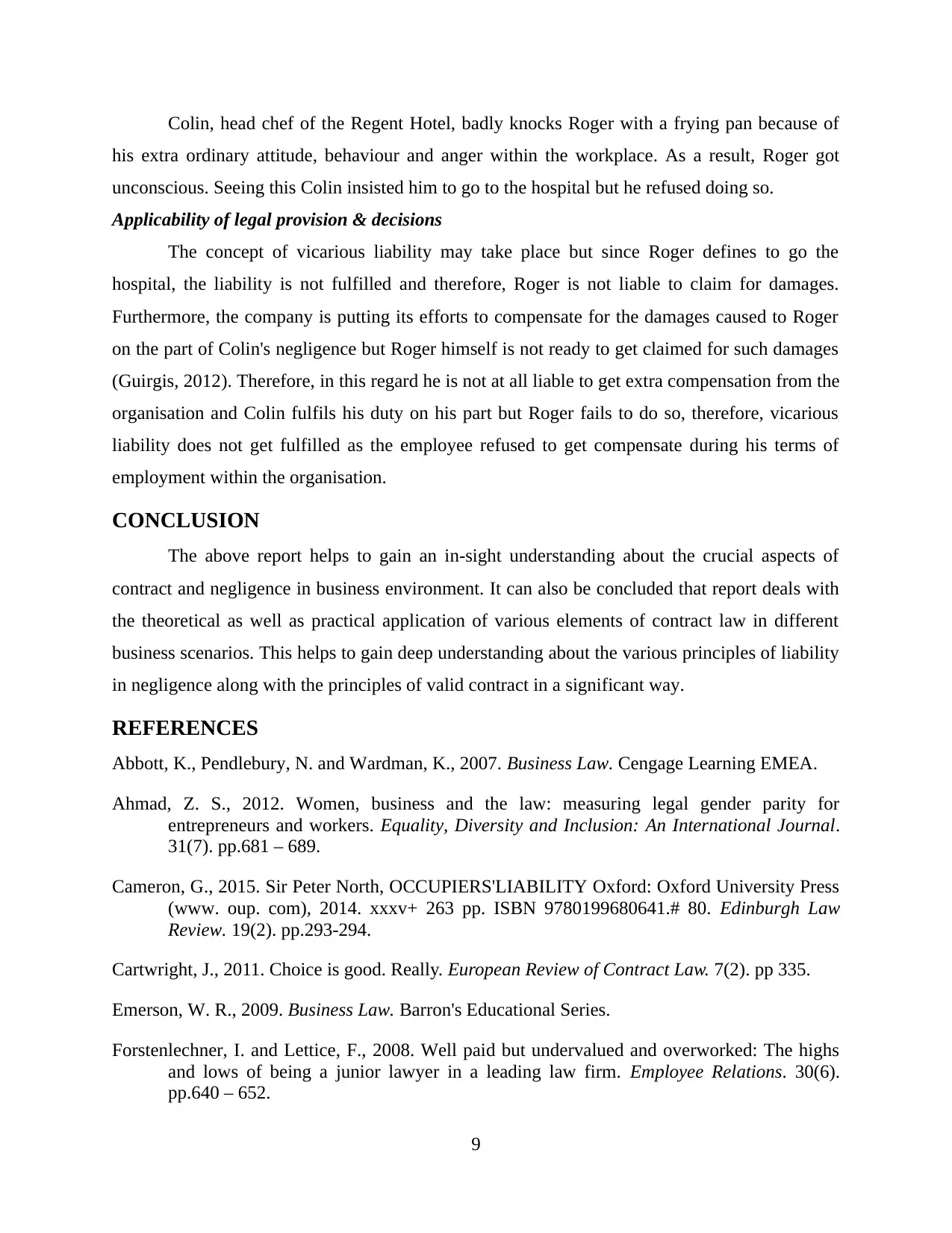
Colin, head chef of the Regent Hotel, badly knocks Roger with a frying pan because of
his extra ordinary attitude, behaviour and anger within the workplace. As a result, Roger got
unconscious. Seeing this Colin insisted him to go to the hospital but he refused doing so.
Applicability of legal provision & decisions
The concept of vicarious liability may take place but since Roger defines to go the
hospital, the liability is not fulfilled and therefore, Roger is not liable to claim for damages.
Furthermore, the company is putting its efforts to compensate for the damages caused to Roger
on the part of Colin's negligence but Roger himself is not ready to get claimed for such damages
(Guirgis, 2012). Therefore, in this regard he is not at all liable to get extra compensation from the
organisation and Colin fulfils his duty on his part but Roger fails to do so, therefore, vicarious
liability does not get fulfilled as the employee refused to get compensate during his terms of
employment within the organisation.
CONCLUSION
The above report helps to gain an in-sight understanding about the crucial aspects of
contract and negligence in business environment. It can also be concluded that report deals with
the theoretical as well as practical application of various elements of contract law in different
business scenarios. This helps to gain deep understanding about the various principles of liability
in negligence along with the principles of valid contract in a significant way.
REFERENCES
Abbott, K., Pendlebury, N. and Wardman, K., 2007. Business Law. Cengage Learning EMEA.
Ahmad, Z. S., 2012. Women, business and the law: measuring legal gender parity for
entrepreneurs and workers. Equality, Diversity and Inclusion: An International Journal.
31(7). pp.681 – 689.
Cameron, G., 2015. Sir Peter North, OCCUPIERS'LIABILITY Oxford: Oxford University Press
(www. oup. com), 2014. xxxv+ 263 pp. ISBN 9780199680641.# 80. Edinburgh Law
Review. 19(2). pp.293-294.
Cartwright, J., 2011. Choice is good. Really. European Review of Contract Law. 7(2). pp 335.
Emerson, W. R., 2009. Business Law. Barron's Educational Series.
Forstenlechner, I. and Lettice, F., 2008. Well paid but undervalued and overworked: The highs
and lows of being a junior lawyer in a leading law firm. Employee Relations. 30(6).
pp.640 – 652.
9
his extra ordinary attitude, behaviour and anger within the workplace. As a result, Roger got
unconscious. Seeing this Colin insisted him to go to the hospital but he refused doing so.
Applicability of legal provision & decisions
The concept of vicarious liability may take place but since Roger defines to go the
hospital, the liability is not fulfilled and therefore, Roger is not liable to claim for damages.
Furthermore, the company is putting its efforts to compensate for the damages caused to Roger
on the part of Colin's negligence but Roger himself is not ready to get claimed for such damages
(Guirgis, 2012). Therefore, in this regard he is not at all liable to get extra compensation from the
organisation and Colin fulfils his duty on his part but Roger fails to do so, therefore, vicarious
liability does not get fulfilled as the employee refused to get compensate during his terms of
employment within the organisation.
CONCLUSION
The above report helps to gain an in-sight understanding about the crucial aspects of
contract and negligence in business environment. It can also be concluded that report deals with
the theoretical as well as practical application of various elements of contract law in different
business scenarios. This helps to gain deep understanding about the various principles of liability
in negligence along with the principles of valid contract in a significant way.
REFERENCES
Abbott, K., Pendlebury, N. and Wardman, K., 2007. Business Law. Cengage Learning EMEA.
Ahmad, Z. S., 2012. Women, business and the law: measuring legal gender parity for
entrepreneurs and workers. Equality, Diversity and Inclusion: An International Journal.
31(7). pp.681 – 689.
Cameron, G., 2015. Sir Peter North, OCCUPIERS'LIABILITY Oxford: Oxford University Press
(www. oup. com), 2014. xxxv+ 263 pp. ISBN 9780199680641.# 80. Edinburgh Law
Review. 19(2). pp.293-294.
Cartwright, J., 2011. Choice is good. Really. European Review of Contract Law. 7(2). pp 335.
Emerson, W. R., 2009. Business Law. Barron's Educational Series.
Forstenlechner, I. and Lettice, F., 2008. Well paid but undervalued and overworked: The highs
and lows of being a junior lawyer in a leading law firm. Employee Relations. 30(6).
pp.640 – 652.
9
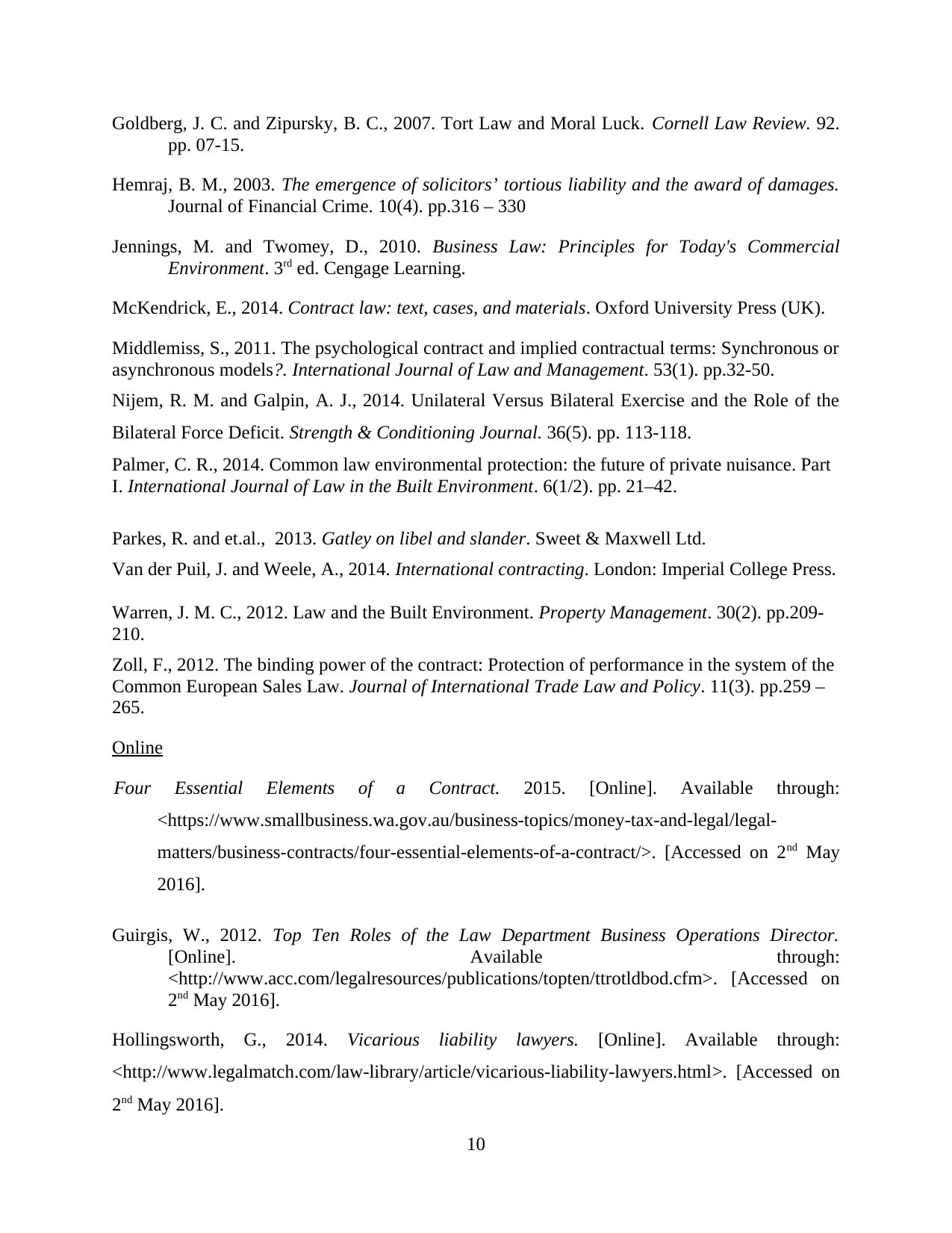
Goldberg, J. C. and Zipursky, B. C., 2007. Tort Law and Moral Luck. Cornell Law Review. 92.
pp. 07-15.
Hemraj, B. M., 2003. The emergence of solicitors’ tortious liability and the award of damages.
Journal of Financial Crime. 10(4). pp.316 – 330
Jennings, M. and Twomey, D., 2010. Business Law: Principles for Today's Commercial
Environment. 3rd ed. Cengage Learning.
McKendrick, E., 2014. Contract law: text, cases, and materials. Oxford University Press (UK).
Middlemiss, S., 2011. The psychological contract and implied contractual terms: Synchronous or
asynchronous models?. International Journal of Law and Management. 53(1). pp.32-50.
Nijem, R. M. and Galpin, A. J., 2014. Unilateral Versus Bilateral Exercise and the Role of the
Bilateral Force Deficit. Strength & Conditioning Journal. 36(5). pp. 113-118.
Palmer, C. R., 2014. Common law environmental protection: the future of private nuisance. Part
I. International Journal of Law in the Built Environment. 6(1/2). pp. 21–42.
Parkes, R. and et.al., 2013. Gatley on libel and slander. Sweet & Maxwell Ltd.
Van der Puil, J. and Weele, A., 2014. International contracting. London: Imperial College Press.
Warren, J. M. C., 2012. Law and the Built Environment. Property Management. 30(2). pp.209-
210.
Zoll, F., 2012. The binding power of the contract: Protection of performance in the system of the
Common European Sales Law. Journal of International Trade Law and Policy. 11(3). pp.259 –
265.
Online
Four Essential Elements of a Contract. 2015. [Online]. Available through:
<https://www.smallbusiness.wa.gov.au/business-topics/money-tax-and-legal/legal-
matters/business-contracts/four-essential-elements-of-a-contract/>. [Accessed on 2nd May
2016].
Guirgis, W., 2012. Top Ten Roles of the Law Department Business Operations Director.
[Online]. Available through:
<http://www.acc.com/legalresources/publications/topten/ttrotldbod.cfm>. [Accessed on
2nd May 2016].
Hollingsworth, G., 2014. Vicarious liability lawyers. [Online]. Available through:
<http://www.legalmatch.com/law-library/article/vicarious-liability-lawyers.html>. [Accessed on
2nd May 2016].
10
pp. 07-15.
Hemraj, B. M., 2003. The emergence of solicitors’ tortious liability and the award of damages.
Journal of Financial Crime. 10(4). pp.316 – 330
Jennings, M. and Twomey, D., 2010. Business Law: Principles for Today's Commercial
Environment. 3rd ed. Cengage Learning.
McKendrick, E., 2014. Contract law: text, cases, and materials. Oxford University Press (UK).
Middlemiss, S., 2011. The psychological contract and implied contractual terms: Synchronous or
asynchronous models?. International Journal of Law and Management. 53(1). pp.32-50.
Nijem, R. M. and Galpin, A. J., 2014. Unilateral Versus Bilateral Exercise and the Role of the
Bilateral Force Deficit. Strength & Conditioning Journal. 36(5). pp. 113-118.
Palmer, C. R., 2014. Common law environmental protection: the future of private nuisance. Part
I. International Journal of Law in the Built Environment. 6(1/2). pp. 21–42.
Parkes, R. and et.al., 2013. Gatley on libel and slander. Sweet & Maxwell Ltd.
Van der Puil, J. and Weele, A., 2014. International contracting. London: Imperial College Press.
Warren, J. M. C., 2012. Law and the Built Environment. Property Management. 30(2). pp.209-
210.
Zoll, F., 2012. The binding power of the contract: Protection of performance in the system of the
Common European Sales Law. Journal of International Trade Law and Policy. 11(3). pp.259 –
265.
Online
Four Essential Elements of a Contract. 2015. [Online]. Available through:
<https://www.smallbusiness.wa.gov.au/business-topics/money-tax-and-legal/legal-
matters/business-contracts/four-essential-elements-of-a-contract/>. [Accessed on 2nd May
2016].
Guirgis, W., 2012. Top Ten Roles of the Law Department Business Operations Director.
[Online]. Available through:
<http://www.acc.com/legalresources/publications/topten/ttrotldbod.cfm>. [Accessed on
2nd May 2016].
Hollingsworth, G., 2014. Vicarious liability lawyers. [Online]. Available through:
<http://www.legalmatch.com/law-library/article/vicarious-liability-lawyers.html>. [Accessed on
2nd May 2016].
10
⊘ This is a preview!⊘
Do you want full access?
Subscribe today to unlock all pages.

Trusted by 1+ million students worldwide
1 out of 12
Related Documents
Your All-in-One AI-Powered Toolkit for Academic Success.
+13062052269
info@desklib.com
Available 24*7 on WhatsApp / Email
![[object Object]](/_next/static/media/star-bottom.7253800d.svg)
Unlock your academic potential
Copyright © 2020–2025 A2Z Services. All Rights Reserved. Developed and managed by ZUCOL.





